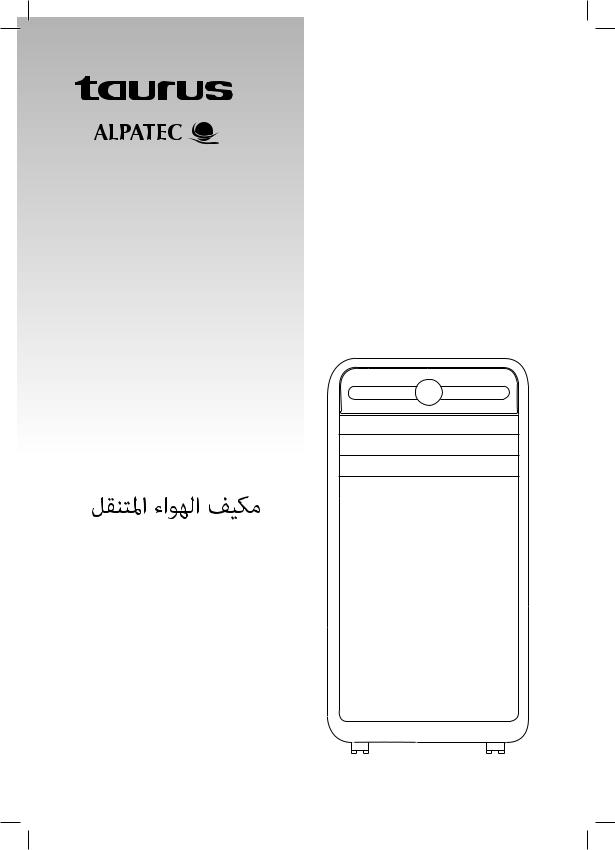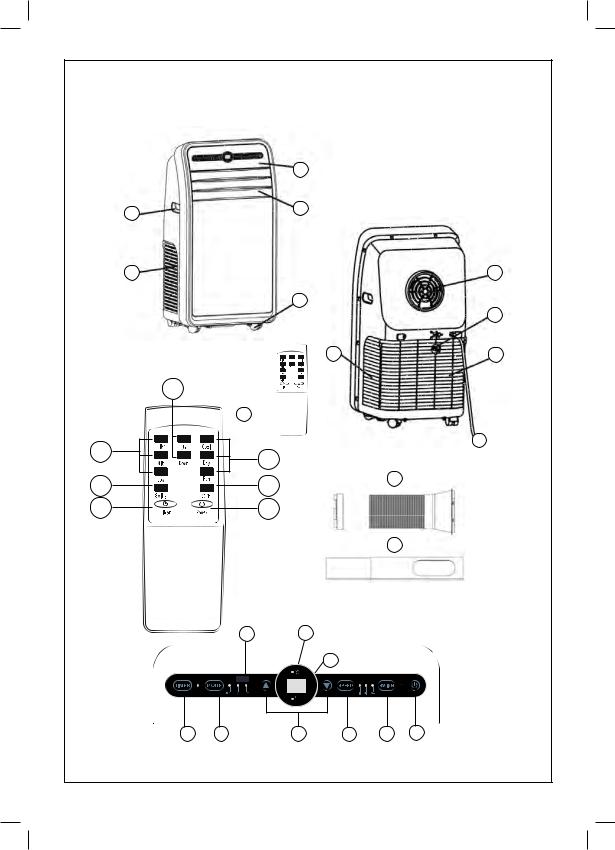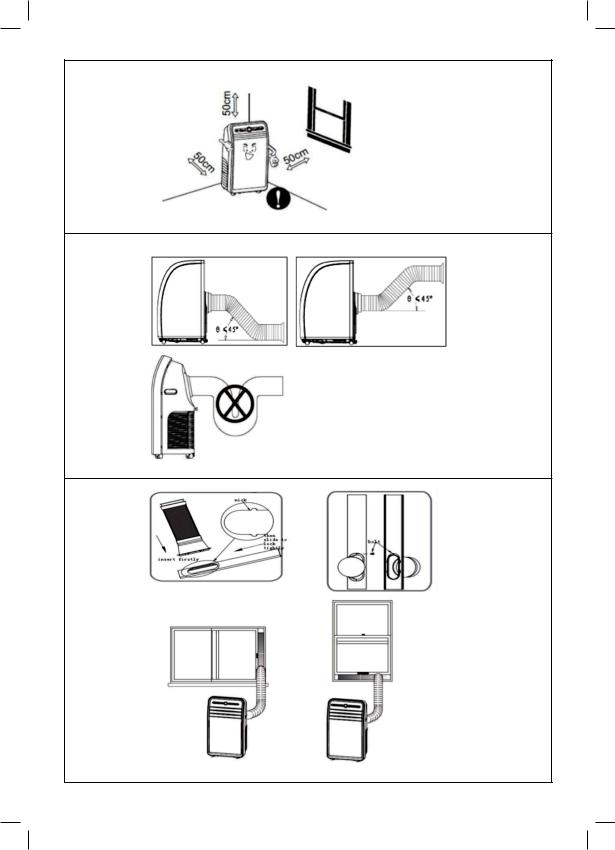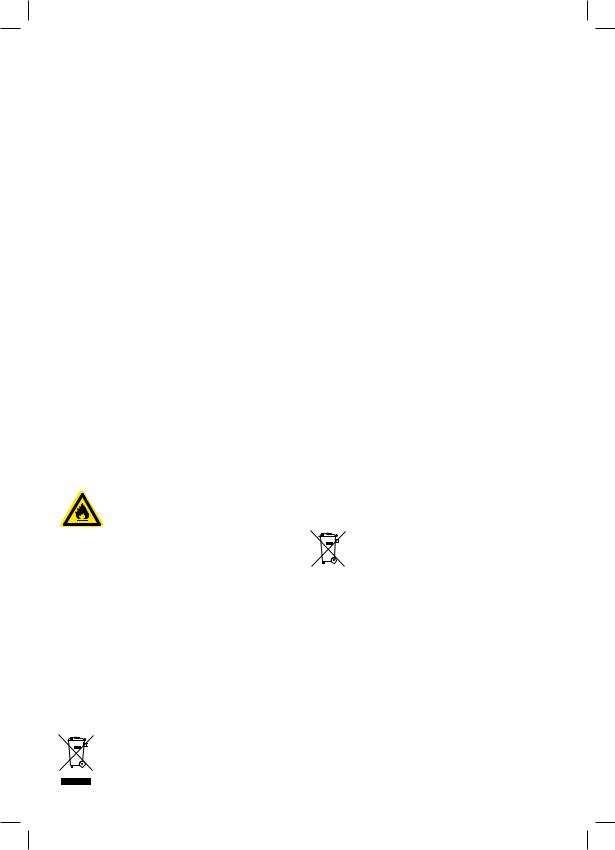Taurus AC 351 KT, AC 351 RVKT User Manual

AC 351 KT
AC 351 RVKT
Aire Acondicionado portátil Portable air conditioning Climatiseur portable Mobiles Klimagerät
Condizionatore portatile
Ar condicionado portátil Draagbare airconditioning
Klimatyzator przenośny Φορητό κλιματιστικό
Портативный кондиционер
Aparat de aer condiţionat portabil
Преносима климатична инсталация

AC 351 KT AC 351 RVKT
3
2
6
B
A D
C H
E
I
G J
4
F 
M
5 |
|
7 |
K |
|
|
1 |
|
|
L |
g* h
f
e |
d |
c |
b |
i |
a |
* Heat AC 351 RVKT

Fig.1
Fig.2
Fig.3

Español
Aire Acondicionado portátil
AC 351 KT - AC 351 RVKT
Distinguido cliente:
Le agradecemos que se haya decidido por la compra de un producto de la marca Taurus Alpatec.
Su tecnología, diseño y funcionalidad, junto con el hecho de superar las más estrictas normas de calidad le comportarán total satisfacción durante mucho tiempo.
 No instale ni use su aire acondicionado móvil antes de leer atentamente este manual. Guarde este manual de instrucciones para una eventual garantía del producto y para referencia futura.
No instale ni use su aire acondicionado móvil antes de leer atentamente este manual. Guarde este manual de instrucciones para una eventual garantía del producto y para referencia futura.
ADVERTENCIA
--No use medios para acelerar el proceso de descongelación o para limpiar, que no sean los recomendados por el fabricante.
--El artefacto debe almacenarse en una habitación sin fuentes de ignición en funcionamiento continuo (por ejemplo: llamas abiertas, un artefacto de gas que funcione o un calentador eléctrico que funcione).
--No perforar ni quemar.
--Tenga en cuenta que los refrigerantes pueden no contener olor.
--El dispositivo debe ser instalado, operado y almacenado en una sala con un área de piso mayor a 11,8 m2.
ADVERTENCIA
--Información específica sobre aparatos con gas refrigerante R290.
--Lea detenidamente todas las advertencias.
--Cuando descongele y limpie la aplicación, no use otras herramientas que no sean las recomendadas por la empresa fabricante.
--El aparato debe colocarse en un área sin fuentes de ignición continuas (por ejemplo: llamas abiertas, gas o aparatos eléctricos en funcionamiento).
--No perforar y no quemar.
--Este aparato contiene 245 gramos del gas refrigerante R290.
--R290 es un gas refrigerante que cumple con las directivas europeas sobre el medio ambiente. No perfore ninguna parte del circuito de refrigerante.
--Si el aparato está instalado, operado o almacenado en un área no ventilada, la habitación debe estar diseñada para evitar la acumulación de fugas de refrigerante, lo que genera un riesgo de incendio o explosión debido a la ignición del refrigerante causada por calentadores eléctricos, estufas o otras fuentes de ignición.

--El aparato debe almacenarse de manera que se evite la falla mecánica.
--Las personas que operan o trabajan en el circuito de refrigerante deben contar con la certificación correspondiente emitida por una organización acreditada que garantice la competencia en el manejo de refrigerantes de acuerdo con una evaluación específica reconocida por las asociaciones de la industria.
--Las reparaciones deben realizarse en base a la recomendación de la empresa fabricante. El mantenimiento y las reparaciones que requieren la asistencia de otro personal calificado deben realizarse bajo la supervisión de un individuo especificado en el uso de refrigerantes inflamables.
CONSEJOS Y ADVERTENCIAS DE SEGURIDAD
--Este aparato pueden utilizarlo niños con edad de 8 años y superior y personas con capacidades físicas, sensoriales o mentales reducidas o falta de experiencia y conocimiento, si se les ha dado la supervisión o formación apropiadas respecto al uso del aparato de una manera segura y comprenden los peligros que implica.
--Este aparato no es un juguete. Los niños deberían ser supervisados para asegurar que no juegan con el aparato.
--No permitir que los niños realicen la limpieza y el mantenimiento sin supervisión.
--Instalar el aparato conforme a las normativas nacionales de cableado.
--Deje un espacio de 30 cm entre las paredes u otros obstáculos y el aparato. No cubrir ni obstruir los laterales del aparato, y dejar un espacio mínimo de 30 cm alrededor del aparato.
--El producto requiere ventilación adecuada para funcionar correctamente.
--El fusible usado en el aparato sus características son: AC 3.15A/250V.
--Si la conexión red está dañada, debe ser substituida. Llevar el aparato a un Servicio de Asistencia Técnica autorizado. No intentar desmontarlo o repararlo usted mismo ya que puede resultar peligroso.
--Antes de conectar el aparato verificar que el voltaje indicado en la placa de características coincide con el de la red.
--Conectar el aparato a una base de toma de corriente que soporte como mínimo 16 amperios.
--La clavija del aparato debe coincidir con la base eléctrica de la toma de corriente. Nunca modificar la clavija. No usar adaptadores de clavija.
--No forzar el cable eléctrico de conexión. Nunca usar el cable eléctrico para levantar, transportar

o desenchufar el aparato.
--No enrollar el cable eléctrico de conexión alrededor del aparato.
--Verificar que el cable eléctrico no está pinzado ni doblado.
--No dejar que el cable eléctrico de conexión quede colgando o quede en contacto con las superficies calientes del aparato.
--Verificar el estado del cable eléctrico de conexión. Los cables dañados o enredados aumentan el riesgo de choque eléctrico.
--Es recomendable como protección adicional en la instalación eléctrica que alimenta el aparato, el disponer de un dispositivo de corriente diferencial con una sensibilidad máxima de 30 mA. Consultar con un instalador.
--No tocar la clavija de conexión con las manos mojadas.
--No utilizar el aparato con el cable eléctrico o la clavija dañada.
--Si alguna de las envolventes del aparato se rompe, desconectar inmediatamente el aparato de la red para evitar la posibilidad de sufrir una descarga eléctrica.
--No utilizar el aparato si ha caído, si hay señales visibles de daños, o si existe fuga.
--Usar el aparato en una zona bien ventilada.
--En caso de utilizar en la misma habitación el aparato con otros aparatos de gas o combustible ésta deberá estar bien ventilada.
--No colocar el aparato donde pueda alcanzarle la luz directa del sol.
--Situar el aparato sobre una superficie horizontal, plana, estable y alejada de fuentes de calor y de posibles salpicaduras de agua.
--No utilizar ni guardar el aparato a la intemperie.
--No exponer el aparato a la lluvia o condiciones de humedad. El agua que entre en el aparato aumentará el riesgo de choque eléctrico.
-- ADVERTENCIA: No utilizar el aparato cerca del agua.
--No forzar el cable eléctrico de conexión. Nunca usar el cable eléctrico para levantar, transportar o desenchufar el aparato. Mantener el aparato lejos de fuentes de calor y cantos vivos.
UTILIZACIÓN Y CUIDADOS:
--Antes de cada uso, desenrollar completamente el cable de alimentación de la fuente de alimentación.
--No usar el aparato si su dispositivo de puesta en marcha/paro no funciona. No retirar las pa-
tas del aparato. No mover el aparato mientras está en uso.
--Hacer uso de las asas para coger o transportar el aparato.
--No dar la vuelta al aparato mientras está en uso o conectado a la red.
--Desenchufar la fuente de alimentación de la red cuando no se use y antes de realizar cualquier operación de limpieza.
--Este aparato está pensado únicamente para uso doméstico, no para uso profesional o industrial.
--Guardar este aparato fuera del alcance de los niños y/o personas con capacidades físicas, sensoriales o mentales reducidas o no familiarizados con su uso.
--No exponer el aparato a temperaturas extremas. Mantener el aparato en un lugar seco, sin polvo y protegido de la luz directa del sol. No dejar nunca el aparato conectado y sin vigilancia. Además ahorrará energía y prolongará la vida del aparato.
--Toda utilización inadecuada, o en desacuerdo con las instrucciones de uso, puede comportar peligro, anulando la garantía y la responsabilidad del fabricante.
SERVICIO
--Asegúrese de que el servicio sea reparado únicamente por personal especializado y que solo se usen piezas de repuesto o accesorios originales para reemplazar las piezas / accesorios existentes.
--Cualquier uso indebido, o en desacuerdo con las instrucciones de uso, puede ser peligroso, anulando la garantía y responsabilidad del fabricante
DESCRIPCIÓN
--A Asa
--B Panel de control
--C Entrada de aire (izquierda)
--D Lamas de aire --E ruedas de ricino
--F control remoto
--G Entrada de aire (derecha)
--H Salida de aire
--I Salida agua
--J rejilla de entrada aire

--K tubo salida aire
--L Placa de ensamblaje ventana
--M Cable de alimentación
CONTROL REMOTO (BATERIAS NO INCLUIDAS)
--1 botón de encendido
--2 botón de swing
--3 botón de selección de velocidad del viento --4 ajuste de temperatura / tiempo arriba y abajo --botón
--5 botón de selección de modo --6 botón de función de tiempo
--7 botón de conversión Celsius y Farenheit
PANEL DE CONTROL
--(a) Botón de encendido / apagado
--(b) Botón de selección de velocidad del viento --(c) Ajuste de aumento de temperatura / tiempo --botón
--(d) botón de selección de modo --(e) botón de función de tiempo
--(f) Ventana de visualización de temperatura / temporizador
--(g) Ventana del receptor de control remoto
--(h) Botón de conversión Fahrenheit y Celsius --(i) Modo swing
* Modo calor AC 351RVKT
--Lea atentamente estas instrucciones antes de encender el aparato y consérvelas para futuras consultas. La no observación y cumplimiento de estas instrucciones pueden comportar como resultado un accidente
INSTALACIÓN
--Asegurarse de retirar todo material de embalaje del interior del aparato.
--Respetar las disposiciones legales referentes a distancias de seguridad con otros elementos tales como tuberías, conducciones eléctricas, etc.
--Asegurarse de que el aparato está bien nivelado respecto al suelo.
--El aparato requiere una ventilación adecuada con el fin de que funcione correctamente. Dejar un espacio de 50cm entre las paredes u otros obstáculos y el aparato. (Fig 1)
--No cubrir ni obstruir ninguna de las aberturas del aparato.
--No cubrir ni obstruir los laterales del aparato, y dejar un espacio mínimo de 50cm alrededor del
aparato.
--La clavija debe ser fácilmente accesible para poder desconectarla en caso de emergencia.
--Colocar el aparato en un lugar con una temperatura entre 12ºC y 32ºC, para lograr la máxima eficacia.
--Comprobar que el tubo de extracción está horizontal. (Fig 2)
--No añadir nueva secciones al tubo de extracción incluido, ya que podría causar el mal funcionamiento del aparato.
--El aparato tiene que ser utilizado con sus pies de apoyo.
--Utilizar el aparato con las ruedas puestas.
MONTAJE DEL TUBO DE ESCAPE
--Estirar el tubo, y enroscar su extremo al conector de la salida de aire (sentido contrario a las agujas del reloj).
--Atención: El tubo de salida de aire mide 60 cm~170 cm (incluido el adaptador).
--La longitud del tubo de salida de aire es conforme a las características técnicas del aparato.
No utilizar tubos de salida de aire de diferentes medidas o materiales, ya que pueden provocar fallos.
INSTALACIÓN DEL KIT DE VENTANA (Fig 3)
--Abrir parcialmente la ventana y después el kit de ventana a la ventana.
--El kit de ventana puede ser instalado en la mayor parte de las ventanas comunes verticales y es ajustable.
--Fijar el otro extremo del tubo de escape de calor a la salida de aire del kit de ventana.
MODO DE EMPLEO
USO:
--Desenrollar completamente el cable antes de conectarlo
--Conectar el aparato a la red.
--Pulsar el botón ON/OFF, el aparato comenzará en Modo frío con el ventilador en velocidad lenta.
--Pulsar el botón modo para seleccionar frío, deshumidificación, ventilador y auto.
VELOCIDAD DEL VENTILADOR
--En modo frío y modo ventilador, la velocidad funciona de la siguiente manera:
--Ventilador Bajo MedioVentilador Alto.
--En modo deshumidificador, el ventilador funciona a baja velocidad.

FUNCIÓN TEMPORIZADOR:
--El tiempo de funcionamiento del aparato puede ser controlado desde 1~24h.
--Pulsar el botón
--Puede programar el tiempo con los botones arriba y abajo.
--La función de autoapagado del temporizador sólo es disponible cuando el aparato está encendido.
--El botón (up) arriba y (down) abajo sirve para programar la temperatura y el temporizador.
--En modo frío y modo calor, el arco de programación de temperatura va de 16º~31ºC.
SWING (BARRIDO)
--Pulse este botón para controlar el movimiento de la rejilla.
MODO FRÍO
--Pulsa modo para seleccionar modo frío, el indicador de modo frío se encenderá.
--Pulsar Arriba o Abajo para ajustar la temperatura en una franja de 8~30ºC (64~86ºF).
--Pulsando Arriba o Abajo una vez, la temperatura aumentará o disminuirá gradualmente 1ºC o 1ºF.
--Pulsar velocidad para seleccionar velocidad alta, media o baja del ventilador.
MODO CALOR AC 351RVKT
--Pulsa modo (d) para seleccionar modo calor, el --indicador de modo calor se encenderá.
--Pulsa (c) para ajustar la temperatura
--Pulsa speed (b) para aumentar o disminuir --la velocidad.
MODO VENTILADOR:
--Pulsa modo para seleccionar el modo ventilador y el indicador de ventilador se encenderá.
--Pulsa speed (velocidad) para aumentar o disminuir la velocidad.
--Temperatura y función de reposo no pueden ser configuradas.
MODO DESHUMIDIFICADOR:
--Presione “MODE” para seleccionar el modo deshumidificación, indicador de modo de deshumidificación se iluminara.
-- Quite el tapón de la tapa de drenaje, inserte un tubo (no incluido) y poner el otro lado del tubo en contenedores de agua o canales de drenaje.
-- Al entrar en el modo de deshumidificación, si la temperatura ambiente es ≥17ºC, el compresor
comenzará a trabajar.
--Si la temperatura ambiente es ≤15ºC, el compresor se detiene
--Cuando la temperatura se eleva a ≥17ºC, el reinicio del compresor (el compresor deberá cumplir con la función de protección de retraso de 3 minutos).
-- En el modo de deshumidificación, el ventilador funciona en baja velocidad por defecto y la velocidad no es ajustable.
--No se puede establecer la temperatura.
-- Nota: Cuando utilice la función de deshumidificación, la manguera de salida de aire caliente no tiene que ser puesta, de lo contrario la deshumidificación no será efectiva o mostrar alarma agua “FL”
PROTECCIÓN DEL COMPRESOR:
--Tres minutos después de pulsar on (encender) / reiniciar, el compresor empezará a funcionar.
PROTECCIÓN DEL DEPÓSITO DE AGUA:
--Cuando el nivel de agua en la placa inferior de agua está por debajo del nivel de advertencia, el aparato le avisará automáticamente.
--Por favor, vierta el agua en la máquina de acuerdo a las indicaciones del capitulo “drenaje de agua”.
DRENAJE DE AGUA:
--Cuando el interior del depósito de agua esté lleno, el indicador se iluminará en la pantalla.
--El aparato entra en el modo standby (reposo).
--Quite el tapón para extraer el agua, apague la máquina y vuelva a encenderla, la máquina funcionará con normalidad.
--Este modelo tiene una función de auto evaporación, en el modo de frío, por favor no haga drenajes continuos para conseguir un mayor efecto de frío.
UNA VEZ FINALIZADO EL USO DEL APARATO:
--Detener el aparato, accionando el interruptor marcha/paro.
--Desenchufar el aparato de la red eléctrica
UNA VEZ FINALIZADO EL USO DEL APARATO:
--Detener el aparato, accionando el botón (A) encendido / apagado
--Desenchufar el aparato de la red eléctrica.
--Desenchufar el aparato de la red y dejarlo enfriar antes de iniciar cualquier operación de

limpieza.
-- Limpiar el conjunto eléctrico y el conector de red con un paño húmedo y secarlos después. NO SUMERGIRLOS NUNCA EN AGUA O
CUALQUIER OTRO LÍQUIDO.
LIMPIEZA
--Limpiar el aparato con un paño húmedo impregnado con unas gotas de detergente. No utilizar disolventes, ni productos con un factor pH ácido o básico como la lejía, ni productos abrasivos, para la limpieza del aparato.
--No sumergir el conector en agua u otro líquido ni ponerlo bajo el grifo. Si el aparato no se mantiene en buen estado de limpieza, su superficie puede degradarse y afectar de forma inexorable la duración de la vida del aparato y conducir a una situación peligrosa.
LIMPIEZA DEL FILTRO DE AIRE:
--Limpie los filtros de aire cada 2 semanas. Si el filtro de aire está bloqueado con polvo, su eficacia se reducirá.
--Lavar los filtros de aire sumergiéndolos cuidadosamente en agua caliente con un detergente neutro, enjuagarlos y dejarlos secar completamente en un lugar a la sombra.
--Instalar los filtros cuidadosamente tras haberlos limpiado.
TRAS MANTENIMIENTO PERIÓDICO:
--Apague el aparato y retire el enchufe.
-- Separe el tubo de escape del aire y guárdelo cuidadosamente.
-- Ponga el aparato en un lugar seco.
-- Retire las pilas del mando a distancia y guárdelas cuidadosamente.
ANOMALÍAS Y REPARACIÓN
--En caso de avería llevar el aparato a un Servicio de Asistencia Técnica autorizado. No intente desmontarlo o repararlo ya que puede existir peligro.
--Toda persona involucrada en trabajar en un circuito de refrigerante debe tener un certificado válido actual de una autoridad de evaluación acreditada por la industria, que autoriza su competencia para manejar refrigerenates de manera segura de acuerdo con una especificación de evaluación reconocida por la industria.
--El mantenimiento solo se realizará según lo recomendado por el fabricante del equipo. El mantenimiento y la reparación que requieren asistenca de otor personal calificado se llevarán a cabo bajo la supervisión de la persona competente en el uso de refrigerantes inflamables.
--En caso de detectar cualquier anomalía consulte la siguiente tabla:
Anomalías |
Causas |
Soluciones |
El aparato no funciona |
No llega corriente. |
Encienda el aparato |
|
Indicador de llenado de agua |
Vierta el agua del interior del contenedor |
|
iluminado |
Poner el aparato en marcha después de |
|
|
haber efectuado el drenaje |
Parece que el aparato |
Ventanas o puertas abiertas |
Corra las cortinas |
no funciona |
El filtro está muy sucio |
Cierre las ventanas |
|
La entrada o la salida de aire |
Limpie o cambie el filtro de aire |
|
está bloqueada |
Limpie el contenedor |
|
La temperatura de la habita- |
Cambie la configuración de la tempe- |
|
ción es inferior a la temperatu- |
ratura |
|
ra configurada |
|
El ruido del aparato es |
El aparato no está puesto en |
Ponga el aparato en una superficie |
demasiado alto |
una superficie plana |
plana que soporte su peso |
El compresor no fun- |
La protección de calentamiento |
Encienda el aparato tras 3 minutos |
ciona |
excesivo está activada |
cuando la temperatura haya disminuido |
Códigos de detección |
Significado |
E1/E2: |
Fallo del sensor de temperatura |
|
|
FL: |
Depósito de agua lleno |
|
|

El aparato contiene refrigerante
inflamable
PARA LAS VERSIONES EU DEL PRODUCTO Y/O EN EL CASO DE QUE EN SU PAÍS APLIQUE:
ECOLOGÍA Y RECICLABILIDAD DEL PRODUCTO
-- Los materiales que constituyen el envase de este aparato, están integrados en un sistema de recogida, clasificación y reciclado de los mismos. Si desea deshacerse de ellos, puede utilizar los contenedores públicos apropiados para cada tipo de material.
-- El producto está exento de concentraciones de sustancias que se puedan considerar dañinas para el medio ambiente.
Este símbolo significa que si desea deshacerse del producto, una vez
transcurrida la vida del mismo, debe depositarlo por los medios adecuados a manos de un gestor de residuos autorizado para la recogida selectiva de Residuos de Aparatos Eléctricos y Electrónicos (RAEE).
Este símbolo significa que el producto
puede disponer de pilas o baterías en su
interior, las cuales deben ser retiradas previamente antes de deshacerse del
producto. Recuerde que las pilas/baterías deben depositarse en contenedores especiales autorizados. Y que nunca deben tirarse al fuego.
Este aparato cumple con la Directiva 2014/35/EU de Baja Tensión, con la Directiva 2014/30/EU de Compatibilidad Electromagnética, con la Directiva 2011/65/EU sobre restricciones a la utilización de determinadas sustancias peligrosas en aparatos eléctricos y electrónicos y con la Directiva
2009/125/EC sobre los requisitos de diseño ecológico aplicable a los productos relacionados con la energía.
AC 351 RVKT / AC 351 KT
Potencia nominal de refrigeración (Prated para refrigeración) |
3,5 kW |
* Potencia nominal de calefacción (Prated para calefacción) |
3,3 kW |
Potencia nominal utilizada para refrigeración (PEER) |
1,37 kW |
* Potencia nominal utilizada para calefacción (PCOP) |
1,20 kW |
Factor de eficiencia energética nominal (EERd) |
2,61 |
Coeficiente de rendimiento nominal (COPd) |
2,75 |
Consumo de energía en modo desactivado por termostato (PTO) |
N/A |
Consumo de energía en modo de espera (PSB) |
0,44 W |
|
|
Consumo de electricidad de los aparatos de conducto único/conducto doble |
Refrigeración: |
(QDD, QSD) |
QSD: 1,303 kWh/h |
|
* Calefacción: |
|
QSD: 1,187 kWh/h |
Nivel de potencia acústica (LWA) |
63 dB(A) |
Potencial de calentamiento global (GWP) |
3 kgCO2 eq. |
(*) Solo disponible en el modelo AC 351 RVKT

INSTRUCCIONES PARA LA REPARACIÓN DE ELECTRODOMÉSTICOS QUE CONTIENEN R290
INSTRUCCIONES GENERALES CONTROLES A LA ZONA
--Antes de comenzar a trabajar en sistemas que contienen refrigerantes inflamables, se requieren controles de seguridad para garantizar que se minimice el riesgo de ignición. Para reparar el sistema de refrigeración, se deben cumplir las siguientes precauciones antes de realizar trabajos en el sistema.
PROCEDIMIENTO DE TRABAJO
-- El trabajo se realizará bajo un procedimiento controlado a fin de minimizar el riesgo de presencia de un gas o vapor inflamable mientras se realiza el trabajo.
ÁREA DE TRABAJO GENERAL
-- Todo el personal de mantenimiento y otras personas que trabajen en el área local recibirán instrucciones sobre la naturaleza del trabajo que se está llevando a cabo. Se debe evitar
el trabajo en espacios confinados. El área alrededor del espacio de trabajo se seccionará. Asegúrese de que las condiciones dentro del área se hayan hecho seguras mediante el control del material inflamable.
COMPROBANDO LA PRESENCIA DE REFRIGERANTE
-- El área debe verificarse con un detector de refrigerante apropiado antes y durante el trabajo, para asegurar que el técnico conozca las atmósferas potencialmente inflamables.
Asegúrese de que el equipo de protección contra fugas que se está utilizando sea adecuado para su uso con refrigerantes inflamables, es decir, antiempañamiento, sellado adecuado o intrínsecamente seguro.
PRESENCIA DE EXTINTOR
-- Si se va a realizar un trabajo en caliente en el equipo de refrigeración o en cualquier pieza asociada, se debe tener a mano un equipo apropiado para extinguir el fuego. Tenga un extintor de polvo seco o CO2 adyacente al área de carga.
SIN FUENTES DE IGNICIÓN
-- Ninguna persona que realice un trabajo en
relación con un sistema de refrigeración que implique exponer cualquier trabajo de tubería que contenga o haya contenido refrigerante inflamable deberá utilizar cualquier fuente de ignición de forma que pueda ocasionar un incendio o una explosión. Todas las posibles fuentes de ignición, incluido el tabaquismo, deben mantenerse lo suficientemente lejos del sitio de instalación, reparación, eliminación y eliminación, durante el cual es posible que se libere refrigerante inflamable en el espacio circundante. Antes de que se lleve a cabo el trabajo, se debe inspeccionar el área alrededor del equipo para asegurarse de que no haya peligros inflamables ni riesgos de ignición. Los letreros de “No Fumar” serán desplegados.
ÁREA VENTILADA
-- Asegúrese de que el área esté abierta o que esté adecuadamente ventilada antes de
ingresar al sistema o realizar cualquier trabajo en caliente. Un grado de ventilación continuará durante el período en que se realice el trabajo.
La ventilación debe dispersar con seguridad cualquier refrigerante liberado y preferiblemente expulsarlo externamente a la atmósfera.
CONTROLES AL EQUIPO DE REFRIGERACIÓN
-- Cuando se cambien componentes eléctricos, deberán ser aptos para el propósito y la especificación correcta. En todo momento se deben seguir las pautas de mantenimiento y servicio del fabricante. En caso de duda, consulte al departamento técnico del fabricante para obtener asistencia. Las siguientes comprobaciones se aplicarán a las instalaciones que utilizan refrigerantes inflamables: el tamaño de la carga está de acuerdo con el tamaño de la habitación en la que se instalan las piezas que contienen refrigerante; la maquinaria de ventilación y las salidas funcionan correctamente y no están obstruidas; si se utiliza un circuito de refrigeración indirecto, se debe verificar la presencia de refrigerante en el circuito secundario; el marcado en el equipo continúa siendo visible
y legible. Marcas y signos que son ilegibles deben ser corregidos; Las tuberías o componentes de refrigeración están instalados en una posición en la que es poco probable que estén expuestos a cualquier sustancia que pueda corroer el componente que contiene refrigerantes, a menos que los componentes estén construidos con materiales que sean intrínsecamente

resistentes a la corrosión o que estén adecuadamente protegidos contra la corroción.
CONTROLES A DISPOSITIVOS ELÉCTRICOS
-- La reparación y el mantenimiento de los componentes eléctricos deben incluir controles de seguridad iniciales y procedimientos de inspección de componentes. Si existe una falla que podría comprometer la seguridad, entonces no se deberá conectar ningún sumi-
nistro eléctrico al circuito hasta que no se haya solucionado satisfactoriamente. Si la falla no se puede corregir de inmediato, pero es necesario continuar con la operación, se debe usar una solución temporal adecuada. Esto se informará al propietario del equipo para que se notifique a todas las partes.
-- Las verificaciones de seguridad iniciales deben incluir: que los condensadores estén descargados: esto debe hacerse de manera segura para evitar la posibilidad de chispas; que no hay cables y componentes eléctricos activos expuestos durante la carga, recuperación o purga del sistema; que hay continuidad de la vinculación de la tierra.
REPARACIONES DE COMPONENTES SELLADOS
-- Durante las reparaciones de los componentes sellados, todos los suministros eléctricos deben desconectarse del equipo que se está trabajando antes de retirar las cubiertas selladas, etc. Si es absolutamente necesario tener un suministro eléctrico al equipo durante el servicio, entonces una forma de funcionamiento permanente de La detección de fugas se debe ubicar en el punto más crítico para advertir sobre una situación potencialmente peligrosa.
-- Se deberá prestar especial atención a lo siguiente para garantizar que, al trabajar con componentes eléctricos, la carcasa no se modifique de forma que se vea afectado el nivel de protección. Esto debe incluir daños a los cables, un número excesivo de conexiones, terminales no hechas a la especificación original, daños a las juntas, ajuste incorrecto de los prensaestopas, etc. Asegúrese de que el aparato esté montado de forma segura.
Asegúrese de que las juntas o los materiales de sellado no se hayan degradado de manera que ya no sirvan para prevenir la entrada de atmósferas inflamables. Las piezas de repuesto deben estar de acuerdo con las especificaciones del fabricante.
-- NOTA El uso de sellador de silicio puede inhibir la efectividad de algunos tipos de equipos de
detección de fugas. Los componentes intrínsecamente seguros no tienen que ser aislados antes de trabajar en ellos.
REPARACIÓN DE COMPONENTES INTRÍNSECAMENTE SEGUROS
-- No aplique cargas inductivas o de capacitancia permanentes al circuito sin asegurarse de que esto no exceda el voltaje y la corriente permitidos para el equipo en uso.
-- Los componentes intrínsecamente seguros son los únicos tipos en los que se puede trabajar mientras se vive en presencia de una atmósfera inflamable. El aparato de prueba debe tener la calificación correcta. Reemplace los componentes solo con partes especificadas por el fabricante. Otras partes pueden provocar la ignición de refrigerante en la atmósfera por una fuga.
CABLEADO
-- Verifique que el cableado no esté sujeto a desgaste, corrosión, presión excesiva, vibración, bordes afilados o cualquier otro efecto ambiental adverso. La verificación también tendrá en cuenta los efectos del envejecimiento o la vibración continua de fuentes tales como compresores o ventiladores.
DETECCIÓN DE REFRIGERANTES INFLAMABLES.
-- Bajo ninguna circunstancia se deberán usar fuentes de ignición potenciales en la búsqueda o detección de fugas de refrigernate. Ne se debe usar una antorcha de haluro (o cualquier otro detector que use una llama desnuda).
MÉTODOS DE DETECCIÓN DE FUGAS
-- Los siguientes métodos de detección de fugas se consideran aceptables para los sistemas que contienen refrigerantes inflamables. Se deben usar detectores electrónicos de fugas para detectar refrigerantes inflamables, pero la sensibilidad puede no ser adecuada o puede requerir una recalibración. (El equipo de detección se debe calibrar en un área sin refrigerante). Asegúrese de que el detector no sea una fuente de ignición potencial y
sea adecuado para el refrigerante utilizado. El equipo de detección de fugas se ajustará a un porcentaje del LFL del refrigerante y se calibrará con el refrigerante empleado y se confirmará el porcentaje apropiado de gas
(máximo del 25%). Los fluidos de detección de fugas son adecuados para usar con la mayoría de los refrigerantes, pero se debe evitar el uso de detergentes que contengan cloro, ya que

el cloro puede reaccionar con el refrigerante y corroer las tuberías de cobre. Si se sospecha una fuga, todas las llamas desnudas deben ser eliminadas / extinguidas. Si se encuentra una fuga de refrigerante que requiere soldadura fuerte, todo el refrigerante debe ser recuperado del sistema o aislado (por medio de válvulas de cierre) en una parte del sistema alejada de la fuga. El nitrógeno libre de oxígeno (OFN) se debe purgar a través del sistema antes y durante el proceso de soldadura fuerte.
EXTRACCIÓN Y EVACUACIÓN
-- Cuando se rompa en el circuito de refrigerante para realizar reparaciones, o para cualquier otro propósito, se deben usar procedimientos convencionales. Sin embargo, es importante que se sigan las mejores prácticas ya que la inflamabilidad es una consideración. Se debe cumplir el siguiente procedimiento: eliminar el refrigerante; purgar el circuito con gas inerte; evacuar; purgar de nuevo con gas inerte; abra el circuito cortando o soldando.La carga de refrigerante se recuperará en los cilindros de recuperación correctos. El sistema se „purgará” con OFN para hacer que la unidad sea segura. Este proceso puede necesitar repetirse varias veces. El aire comprimido u oxígeno no se debe usar para esta tarea. El enjuague debe lograrse rompiendo el vacío en el sistema con OFN y continua llenándose hasta que se logre la presión de trabajo, luego se expulse a la atmósfera y finalmente se reduzca al vacío.
Este proceso se repetirá hasta que no haya refrigerante dentro del sistema. Cuando se utiliza la carga final de OFN, el sistema debe descargarse a la presión atmosférica para permitir que se lleve a cabo el trabajo. Esta operación es absolutamente vital si se van a realizar operaciones de soldadura fuerte en la tubería. Asegúrese de que la salida de la bomba de vacío no esté cerca de ninguna fuente de ignición y que haya ventilación disponible.
PROCEDIMIENTOS DE CARGA
-- Además de los procedimientos de carga convencionales, se deben seguir los siguientes requisitos.
--Asegúrese de que no haya contaminación de diferentes refrigerantes cuando utilice el equipo de carga. Las mangueras o líneas deben ser lo más cortas posible para minimizar la cantidad de refrigerante que contienen.
--Los cilindros deben mantenerse en posición vertical.
--Asegúrese de que el sistema de refrigeración esté conectado a tierra antes de cargar el sistema con refrigerante.
--Etiquete el sistema cuando la carga esté completa (si no es así).
--Se debe tener extremo cuidado de no sobrellenar el sistema de refrigeración.
-- Antes de recargar el sistema, se someterá a prueba de presión con OFN. El sistema se probará contra fugas al finalizar la carga, pero antes de la puesta en marcha. Se debe realizar una prueba de fuga de seguimiento antes de abandonar el sitio.
DESMANTELAMIENTO
-- Antes de llevar a cabo este procedimiento, es esencial que el técnico esté completamente familiarizado con el equipo y todos sus detalles. Se recomienda como buena práctica que todos los refrigerantes se recuperen de manera segura. Antes de llevar a cabo la tarea, se tomará una muestra de aceite y refrigerante en caso de que se requiera un análisis antes de
la reutilización del refrigerante regenerado. Es esencial que la energía eléctrica esté disponible antes de comenzar la tarea.
a)Familiarizarse con el equipo y su funcionamiento.
b)Aislar el sistema eléctricamente.
c)Antes de intentar el procedimiento, asegúrese de que: el equipo de manejo mecánico esté disponible, si es necesario, para el manejo de cilindros de refrigerante; todo el equipo de protección personal está disponible y se usa correctamente; el proceso de recuperación es supervisado en todo momento por una persona competente; Los equipos y cilindros de recuperación cumplen con los estándares apropiados.
d)Bombee el sistema de refrigerante, si es posible.
e)Si no es posible el vacío, haga un colector para que el refrigerante se pueda extraer de varias partes del sistema.
f)Asegúrese de que el cilindro esté situado en la báscula antes de que tenga lugar la recuperación.
g)Arranque la máquina de recuperación y opere de acuerdo con las instrucciones del fabricante.
h)No llene demasiado los cilindros. (No más del 80% de carga líquida de volumen).
i)No exceda la presión máxima de trabajo del cilindro, aunque sea temporalmente.

j)Cuando los cilindros se hayan llenado correctamente y se haya completado el proceso, asegúrese de que los cilindros y el equipo se retiren del sitio de inmediato y que todas las válvulas de aislamiento del equipo estén cerradas.
k)El refrigerante recuperado no debe cargarse en otro sistema de refrigeración a menos que haya sido limpiado y verificado.
ETIQUETADO
-- El equipo debe estar etiquetado indicando que ha sido desactivado y vaciado del refrigerante.
La etiqueta deberá estar fechada y firmada.
-- Asegúrese de que haya etiquetas en el equipo que indiquen que el equipo contiene refrigerante inflamable.
RECUPERACIÓN
-- Cuando se retira el refrigerante de un sistema, ya sea para el mantenimiento o la clausura, se recomienda una buena práctica para que todos los refrigerantes se eliminen de manera segura. Al transferir refrigerante a los cilindros, asegúrese de que solo se empleen cilindros de recuperación de refrigerante apropiados. Asegúrese de que esté disponible la cantidad correcta de cilindros para retener la carga total del sistema. Todos los cilindros que se utilizarán están diseñados para el refrigerante recuperado y etiquetados para ese refrigerante (es decir, cilindros especiales para la recuper-
ación de refrigerante). Los cilindros deben estar completos con válvula de alivio de presión y válvulas de cierre asociadas en buen estado de funcionamiento. Los cilindros de recuperación vacíos se evacuan y, si es posible, se enfrían antes de que se produzca la recuperación.
-- El equipo de recuperación debe estar en buen estado de funcionamiento con un conjunto de instrucciones relativas al equipo que se tiene a mano y debe ser adecuado para la recuperación de refrigerantes inflamables. Además, debe haber un juego de balanzas calibradas disponible y en buen estado de funcionamiento. Las mangueras deben estar completas con acoplamientos de desconexión libres de fugas y en buenas condiciones. Antes de usar la máquina de recuperación, verifique que esté en buen estado de funcionamiento, que se haya mantenido adecuadamente y que todos los componentes eléctricos asociados estén sellados para evitar el encendido en caso de que se libere refrigerante. Consulte al fabricante si tiene dudas.
-- El refrigerante recuperado se devolverá al proveedor de refrigerante en el cilindro de recuperación correcto y se colocará la Nota de transferencia de residuos correspondiente. No mezcle refrigerantes en unidades de recuperación y especialmente no en cilindros.
-- Si los compresores o aceites del compresor deben ser removidos, asegúrese de que hayan sido evacuados a un nivel aceptable para asegurarse de que el refrigerante inflamable no permanezca dentro del lubricante. El proce-
so de evacuación se llevará a cabo antes de devolver el compresor a los proveedores. Para acelerar este proceso, solo debe emplearse calefacción estéctrica en el cuerpo del compresor. Cuando se extrae el aceite de un sistema, debe llevarse a cabo de manera segura.
COMPETENCIA DEL PERSONAL DE SERVICIO
GENERAL
-- Se requiere capacitación especial adicional a los procedimientos habituales de reparación de equipos de refrigeración cuando el equipo con refrigerantes inflamables se ve afectado.
-- En muchos países, esta capacitación se lleva a cabo por organizaciones nacionales de capacitación que están acreditadas para enseñar las normas de competencia nacional relevantes que pueden establecerse en la legislación.
-- La competencia lograda debe estar documentada por un certificado.
FORMACIÓN
-- La capacitación debe incluir el contenido de lo siguiente:
-- Información sobre el potencial de explosión de refrigerantes inflamables para demostrar que los productos inflamables pueden ser peligrosos si se manipulan sin cuidado.
-- Información sobre posibles fuentes de ignición, especialmente aquellas que no son obvias, como encendedores, interruptores de luz, aspiradoras, calentadores eléctricos.
-- Información sobre los diferentes conceptos de seguridad:
-- Sin ventilación (ver Cláusula GG.2) La seguridad del aparato no depende de la ventilación de la carcasa. La desconexión del aparato o la apertura de la carcasa no tiene ningún efecto significativo en la seguridad. Sin embargo, es posible que se acumule refrigerante con fugas dentro del gabinete y se liberará una atmósfera inflamable cuando se abra el gabinete.

-- Recinto ventilado (ver Cláusula GG.4) La seguridad del artefacto depende de la ventilación de la carcasa. La desconexión del aparato o la apertura del armario tiene un efecto significativo en la seguridad. Se debe tener cuidado para garantizar una ventilación suficiente antes.
-- Sala ventilada (ver Cláusula GG.5) La seguridad del aparato depende de la ventilación de la habitación. La desconexión del aparato o la apertura de la carcasa no tiene ningún efecto significativo en la seguridad. La ventilación de la habitación no se desconectará durante los procedimientos de reparación.
-- Información sobre el concepto de componentes sellados y envolventes sellados según IEC 6007915: 2010.
-- Información sobre los procedimientos de trabajo correctos:
PUESTA EN SERVICIO
-- Asegúrese de que el área del piso sea suficiente para la carga de refrigerante o de que el conducto de ventilación esté ensamblado de la manera correcta.
-- Conecte las tuberías y realice una prueba de fugas antes de cargar el refrigerante.
-- Verifique el equipo de seguridad antes de ponerlo en servicio.
MANTENIMIENTO
-- El equipo portátil debe repararse en el exterior o en un taller especialmente equipado para reparar unidades con refrigerantes inflamables.
-- Asegure suficiente ventilación en el lugar de reparación.
-- Tenga en cuenta que el mal funcionamiento del equipo puede ser causado por la pérdida de refrigerante y es posible que haya una fuga de refrigerante.
-- Descargue los condensadores de manera que no provoquen chispas. El procedimiento estándar para cortocircuitar los terminales del condensador generalmente crea chispas.
-- Vuelva a armar los armarios sellados con precisión. Si los sellos están desgastados, reemplácelos.
-- Verifique el equipo de seguridad antes de ponerlo en servicio.
REPARAR
-- El equipo portátil debe repararse en el exterior o en un taller especialmente equipado para reparar unidades con refrigerantes inflamables.
-- Asegure suficiente ventilación en el lugar de
reparación.
-- Tenga en cuenta que el mal funcionamiento del equipo puede ser causado por la pérdida de refrigerante y es posible que haya una fuga de refrigerante.
-- Descargue los condensadores de manera que no provoquen chispas.
-- Cuando se requiera soldadura fuerte, los siguientes procedimientos se llevarán a cabo en el orden correcto:
--Retire el refrigerante. Si las regulaciones nacionales no requieren la recuperación, drene el refrigerante hacia el exterior. Tenga cuidado de que el refrigerante drenado no cause ningún peligro. En la duda, una persona debe guardar la salida. Tenga especial cuidado de que el refrigerante drenado no flote nuevamente dentro del edificio.
--Evacuar el circuito de refrigerante.
--Purgue el circuito de refrigerante con nitrógeno durante 5 minutos.
--Evacuar nuevamente.
--Retire las piezas que se reemplazarán cortando, no por llama.
--Purgue el punto de soldadura con nitrógeno durante el procedimiento de soldadura fuerte.
--Realice una prueba de fugas antes de cargar refrigerante.
-- Vuelva a armar los armarios sellados con precisión. Si los sellos están desgastados, reemplácelos.
-- Verifique el equipo de seguridad antes de ponerlo en servicio.
DESMANTELAMIENTO
-- Si la seguridad se ve afectada cuando el equipo se pone fuera de servicio, la carga de refrigerante deberá eliminarse antes de la clausura.
-- Asegure una ventilación suficiente en la ubicación del equipo.
-- Tenga en cuenta que el mal funcionamiento del equipo puede ser causado por la pérdida de refrigerante y es posible que haya una fuga de refrigerante.
-- Descargue los condensadores de manera que no provoquen chispas.
-- Retire el refrigerante. Si las regulaciones nacionales no requieren la recuperación, drene el refrigerante hacia el exterior. Tenga cuidado de que el refrigerante drenado no cause ningún peligro. En la duda, una persona debe guardar la salida. Tenga especial cuidado de que el re-

frigerante drenado no flote nuevamente dentro del edificio.
-- Evacuar el circuito de refrigerante.
-- Purgue el circuito de refrigerante con nitrógeno durante 5 minutos.
-- Evacuar nuevamente.
-- Llene con nitrógeno hasta la presión atmosférica.
-- Coloque una etiqueta en el equipo que indique que se retiró el refrigerante.
ELIMINACIÓN
-- Asegurar una ventilación suficiente en el lugar de trabajo.
-- Retire el refrigerante. Si las regulaciones nacionales no requieren la recuperación, drene el refrigerante hacia el exterior. Tenga cuidado de que el refrigerante drenado no cause ningún peligro. En la duda, una persona debe guardar la salida. Tenga especial cuidado de que el refrigerante drenado no flote nuevamente dentro del edificio.
-- Evacuar el circuito de refrigerante.
-- Purgue el circuito de refrigerante con nitrógeno durante 5 minutos.
-- Evacuar nuevamente.
-- Cortar el compresor y drenar el aceite.
TRANSPORTE, MARCADO Y ALMACENAMIENTO PARA UNIDADES QUE EMPLEAN REFRIGERANTES INFLAMABLES TRANSPORTE DE EQUIPOS QUE CONTIENEN REFRIGERANTES INFLAMABLES
-- Se llama la atención sobre el hecho de que pueden existir regulaciones de transporte adicionales con respecto a los equipos que contienen gases inflamables. La cantidad máxima de equipos o la configuración del equipo, que se permite transportar juntos, estará determinada por las normas de transporte aplicables.
MARCADO DE EQUIPOS CON SIGNOS
-- Los avisos de electrodomésticos similares que se usan en un área de trabajo generalmente son tratados por las reglamentaciones locales y brindan los requisitos mínimos para la provisión de señales de seguridad y / o de salud para un lugar de trabajo.
-- Se deben mantener todos los letreros requeridos y los empleadores deben asegurarse de que los empleados reciban instrucción y capacitación adecuada y suficiente sobre el significado de las señales de seguridad apro-
piadas y las acciones que deben tomarse en relación con estas señales.
-- La efectividad de los signos no debe verse disminuida por demasiados signos que se colocan juntos.
-- Cualquier pictograma utilizado debe ser lo más simple posible y contener solo detalles esenciales.
ELIMINACIÓN DE EQUIPOS QUE UTILIZAN REFRIGERANTES INFLAMABLES
-- Ver regulaciones nacionales.
ALMACENAMIENTO DE EQUIPOS / ELECTRODOMÉSTICOS
-- El almacenamiento del equipo debe estar de acuerdo con las instrucciones del fabricante.
-- Almacenamiento de equipos empacados (sin vender)
-- La protección del paquete de almacenamiento debe estar construida de tal manera que el daño mecánico al equipo dentro del paquete no cause una fuga de la carga de refrigerante.
-- La cantidad máxima de equipos permitidos para almacenarse juntos será determinado por las regulaciones locales.

English
Portable air conditioning
AC 351 KT - AC 351 RVKT
Dear customer,
Many thanks for choosing to purchase a Taurus Alpatecbrand product.
Thanks to its technology, design and operation and the fact that it exceeds the strictest quality standards, a fully satisfactory use and long product life can be assured.
 Please do not install or use your mobile air conditioner before you have carefully read this manual. Please keep this instructions manual for an eventual product warranty and for future reference.
Please do not install or use your mobile air conditioner before you have carefully read this manual. Please keep this instructions manual for an eventual product warranty and for future reference.
WARNING
--Do not use means to accelerate the defrosting process or to clean, other than those recommended by the manufacturer.
--The appliance shall be stored in a room without continuously operating ignition sources
(for example: open flames, an operating gas appliance or an operating electric heater.
--Do not pierce or burn.
--Be aware the refrigerants may not contain an odour.
--Appliance shall be installed, operated and stored in a room with a floor area larger than
11,8 m2.
WARNING
--Specific information regarding
appliances R290 refrigerant gas.
--Thoroughly read all of the warnings.
--When defrosting and cleaning the aplliance, do not use any tools other than those recommended by the manufacturing company.
--The appliance must be placed in an area without any continuously sources of ignition (for example: open flames, gas or electrical appliances in operation).
--Do not puncture and do not burn.
--This appliance contains 245 g (see rating label back of unit) of R290 refrigerant gas.
--R290 is a refrigerant gas that complies with the European directives on the environment. Do not puncture any part of the refrigerant circuit.
--If the appliance is installed, operated or stored in a nonventilated area, the room must be designed to prevent to the accumulation of refrigerant leaks resulting in a risk of fire or explosion due to ignition of the refrigerant caused by electric heaters, stoves, or other sources of ignition.
--The appliance must be stored in such a way as to prevent

mechanical failure.
--Individuals who operate or work on the refrigerant circuit must have the appropriate certification issued by an accredited organization that ensures competence in handling refrigerants according to a specific evaluation recognized by associations in the industry.
--Repairs must be performed based on the recommendation from the manufacturing company. Maintenance and repairs that require the assistance of other qualified personnel must be performed under the supervision of an individual specified in the use of flammable refrigerants.
SAFETY ADVICE AND WARNINGS
--This appliance may be used by children aged 8 years and over and persons with reduced physical, sensory or mental capabilities or lack of experience and knowledge, if they have
been given appropriate supervision or training in the use of the appliance in a safe and Understand the dangers involved.
--This appliance is not a toy. Children should be supervised to ensure that they do not play with the appliance.
--Do not allow children to perform cleaning and maintenance without supervision.
--Install the appliance in accordance with national wiring regulations.
--Leave a space of 30cm between walls or other obstacles and the appliance. Do not cover or obstruct the sides of the appliance, leaving at least 30 cm space around the appliance.
--The product requires adequate ventilation in order to function properly.
--The fuse used in the appliance is type: AC 3.15A, electrical characteristics: 250V.
--If the mains connection is damaged, it must be replaced. Take the appliance to an authorized service center. Do not attempt to disassemble or repair it yourself as it may be dangerous.
-- Before connecting the appliance, check that the voltage indicated on the nameplate matches the voltage on the rating plate.
-- Connect the appliance to a power socket that supports at least 16 amps.
-- The appliance plug must match the electrical socket of the socket. Never modify the plug. Do not use plug adapters.
-- Do not force the connecting cable. Never use the power cord to lift, carry or unplug the appliance.
-- Do not wrap the power cord around the appliance.
-- Check that the power cord is not pinched or bent.
-- Do not allow the connecting cord to hang or touch the hot surfaces of the appliance.

-- Check the condition of the electrical connection cable. Damaged or entangled cables increase the risk of electric shock.
-- It is recommended as an additional protection in the electrical installation that feeds the device, the use of a differential current device with a maximum sensitivity of 30 mA. Consult with an installer.
-- Do not touch the plug with wet hands.
-- Do not use the appliance with the damaged power cord or plug.
-- If any of the enclosures of the appliance breaks, immediately switch off the appliance
-- To avoid the possibility of electric shock.
-- Do not use the appliance if it has fallen, if there are visible signs of damage, or if there is a leak.
-- Use the appliance in a wellventilated area.
-- If the appliance is used in the same room with other gas or fuel appliances, it must be well ventilated.
-- Do not place the appliance in direct sunlight.
-- Place the appliance on a horizontal, flat, stable surface away from sources of heat and possible splashing water.
-- Do not use or store the appliance outdoors.
-- Do not expose the appliance to rain or moisture. Water entering the appliance will increase the risk of electric shock.
-- WARNING: Do not use the appliance near water.
-- Do not force the connecting cable. Never use the power cord to lift, carry or unplug the appliance. Keep the device away from heat sources and sharp edges.
USE AND CARE:
-- Before each use, completely unplug the power cable from the power supply.
-- Do not use the appliance if its start / stop device does not work. Do not remove the legs from the appliance. Do not move the appliance while it is in use.
-- Use the handles to take or transport the appliance.
-- Do not turn the appliance over while it is in use or connected to the mains.
-- Unplug the power supply from the mains when not in use and before performing any cleaning operations.
--This appliance is intended for household use only, not for professional or industrial use.
-- Keep this appliance out of the reach of children and / or persons with reduced physical, sensory or mental abilities or who are unfamiliar with its use.
-- Do not expose the appliance to extreme temperatures. Keep the device in a dry, dustfree place protected from direct sunlight. Never leave the appliance unattended. It will also save energy and prolong the life of the device.
-- Any improper use, or in disagreement with the instructions for use, can be dangerous, voiding the manufacturer’s warranty and liability.
SERVICE
-- Make sure that the appliance is serviced only by specialist personnel, and that only original spare parts or accessories are used to replace existing parts/accessories.
-- Any improper use, or in disagreement with the instructions for use, can be dangerous, voiding the manufacturer’s warranty and liability.
DESCRIPTION
--A Handle
--B Control panel
--C Air inlet (left) --D Air guide bar --E Castor wheels
--F Remote controller --G Air inlet (right)
--H Air outlet --I Outfall
--J Inlet grille
--K Exhaust pipe assembly
--L Window seal plate assembly
--M Power cord
REMOTE CONTROL (BATTERIES NOT INCLUDED)
--1 Power button --2 Swing button
--3 Wind speed selection button
--4 Temperature /Time up and down adjustment --button
--5 Mode selection button
--6 Timing function button
--7 Fahrenheit and Celsius conversion button
CONTROL PANEL
-- (a) Power button
-- (b) Wind speed selection button

--(c) Temperature /Time upanddown adjustment --button
--(d) Mode selection button
--(e) Timing function button
--(f) Temperature /Timer display window
--(g) Remote control receiver window
--(h) Fahrenheit and Celsius conversion button
--(i) Swing mode
* Heat mode AC 351 RVKT
INSTALLATION
-- Be sure to remove all packaging material from inside the appliance.
-- Respect the legal provisions concerning safety distances from other elements such as pipes, electrical connections, etc.
-- Ensure that the appliance is level with respect to the floor.
-- The appliance requires suitable ventilation in order to work properly. Leave a space of 50cm between walls or other obstacles. (Fig 1)
-- Do not cover or obstruct any of the openings of the appliance.
-- Do not cover or obstruct the sides of the appliance, and leave a minimum space of 50cm front other walls, ceiling..
-- The plug must be easily accessible so it can be disconnected in an emergency.
-- To achieve the highest efficiency from the appliance it should be situated in a place where the atmospheric temperature is between 12 and 32ºC.
-- Ensure that the extraction pipe remains in a horizontal position. (Fig 2)
-- Do not add new sections to the extraction tube provided, as it could cause the appliance to malfunction.
-- The appliance should be used with its base feet fitted.
-- The appliance should be used with its wheels attached.
ASSEMBLY OF THE EXHAUST HOSE
--Lengthen one head of the hose, and spin the exhaust hose into exhaust connector (counterclockwise).
--Caution: Exhaust pipe is 60 cm~170 cm long (including adapter).
--The length of exhaust pipe is especially designed in accordance with the specification of the air conditioner. Please do not use other exhaust pipes of different lengths or materials, in such way failure may be caused.
INSTALLATION OF WINDOW KIT (Fig 3)
--Partially open the window and then fix the window kit to the window.
--The window kit can be installed on most of normal and vertical windows and it is adjustable.
-- Fix the other end of the heatexhausted hose to the airoutlet window kit.
INSTRUCTIONS FOR USE
USE:
--Unroll the cable completely before plugging it in. --Connect the appliance to the mains.
--Press the ON/OFF button, the unit will enter in cooling mode with low fan speed.
--Press the mode button to select cooling dehumidifying, fan mode.
FAN SPEED
--Under the cooling and the fan mode, the speed goes as follow:
-- Lower Fan→Mid Fan> High Fan.
--Temperature cannot be set.
TIMER MODE
--In standby mode, press time button to set time start. Press the upanddown button to the time of start (0~24 hours), and time indicator light is on.
--In startup mode, press time button to set time switchoff.
--Press the upanddown button to the time of switchoff (0~24 hours), and time indicator light is on.
SWING
--Press this button to control the movement of the louver.
COOLING MODE:
--Press mode to select cooling mode, cooling mode indicator turns on.
--Press Up or Down to adjust temperature in a range of 17ºC~30ºC.
--When the up or down is pressed once, temperature will go up or down by 1ºC every time.
--Press speed to select high, mid or low fan speed.
HEAT MODE
---Press mode (d) to select heat mode, the --Heat mode indicator will light.
--Press (c) to adjust the temperature
--Pulsa speed (b) to increase or decrease --speed.

FAN MODE:
--Press mode to select fan mode fan indicator turns on.
--Press speed to select high, mid or low speeds.
--In that mode, press Speed for 5 seconds to run the internal dry function, i.e. both upper and lower fans work simultaneously. Press Speed for another 5 seconds to cancel the internal dry function.
--Temperature is not adjustable.
--Press Swing to turn off or turn on the up/down swing function.
DEHUMIDIFYING MODE:
-- Press “MODE” to select dehumidifying mode, dehumidifying mode indicator turns on.
-- Remove the plug of drainage cap, insert a tube and put the other side of the tube into water containers or drain channels.
--When entering dehumidification mode, if the room temperatures is ≥17ºC, the compressor will start to work.
--If the room temperature is ≤15ºC, compressor stops; when the temperature rises back to
≥17ºC, the compressor restarts (the compressor shall meet the 3minute delay protection function).
-- In dehumidification mode, the fan run in low speed by default, and the wind speed are not adjustable. ·Temperature cannot be set.
--NOTE: When the dehumidification function is in use, the exhaust pipe assembly shall be removed; otherwise it will lead to not obvious
dehumidification effect or display “FL” water full alarm.
COMPRESSOR PROTECTION:
-- Three minutes later after power on / restart, compressor starts to run.
WATER TANK FULL PROTECTION:
-- When the water level in the bottom water plate is above the warning level, the unit will alert automatically a.
--Please discharge water in the machine according to chapter “water drainage”.
WATER DRAINAGE:
-- When the inner water tank is full, its indicator will flash on the screen.
-- The appliance enters into standby mode.
-- Pull out the plug to drain out water, power off the machine and restart it , the machine will
runs normally .
--This model have self evaporative function, under cooling mode, please do not use continue drainage to get better cooling effect.
--Once you have finished using the appliance:
-- Turn the appliance off, using the on/off switch.
-- Unplug the appliance from the mains.
ONCE THE APPLIANCE HAS BEEN USED:
-- Stop the appliance by pressing button (A) on/off -- Unplug the appliance from the mains.
-- Unplug the appliance from the mains and allow it to cool down before starting any cleaning operation.
-- Clean the electrical assembly and the mains plug with a damp cloth and dry them afterwards. NEVER SUBMIT THEM IN WATER OR
ANY OTHER LIQUID.
CLEANING
-- Wipe the appliance with a damp cloth impregnated with a few drops of detergent. Do not use solvents or products with an acidic or basic pH factor such as bleach or abrasive products to clean the apparatus.
-- Do not immerse the connector in water or other liquid or place it under the tap. If the appliance is not maintained in good condition
-- Cleaning, its surface can be degraded and inexorably affect the life of the appliance and lead to a dangerous situation.
CLEANING THE AIR FILTER:
-- Clean the air filters every 2 weeks. If the air filter is blocked with dust, its effectiveness will be reduced.
-- Washing the air filters by submerging them
-- Carefully in warm water with a neutral detergent, rinse them off and let them dry completely in a shady place.
-- Install the filters carefully after having them cleaned.
AFTER PERIODIC MAINTENANCE:
-- Switch off the appliance and remove the plug.
-- Separate the exhaust pipe from the air and store it carefully.
-- Put the appliance in a dry place.
-- Remove the batteries from the remote control and store them carefully.

ANOMALIES AND REPAIR |
|
in accordance with an industry recognized |
|||||
-- In the event of a fault, take the appliance to an |
|
assessment specification. |
|||||
-- Servicing shall only be performed as recom- |
|||||||
authorized service center. Do not attempt to dis- |
|||||||
|
mended by the equipment manufacturer. Main- |
||||||
assemble or repair it as there may be danger. |
|
||||||
|
tenance and repair requiring the assistance |
||||||
-- Any person who is involved with working on or |
|
||||||
|
of other skilled personnel shall be carried out |
||||||
breaking into a refrigerant circuit should hold a |
|
||||||
|
under the supervision of the person competent |
||||||
current valid certificate from an industryaccred- |
|
||||||
|
in the use of flammable refrigerants. |
||||||
ited assessment authority, which authorizes |
|
||||||
-- If any fault is detected, refer to the following |
|||||||
their competence to handle refrigerants safely |
|||||||
|
table: |
|
|||||
|
|
|
|
|
|||
|
|
|
|
|
|
|
|
Problem |
Causes |
|
|
|
Solutions |
||
Product is not working |
No llega corriente. |
|
|
|
Switch on device |
||
|
Indicador de llenado de agua |
|
Empty water tank |
||||
|
iluminado |
|
|
|
Start device after empty water tank |
||
|
|
|
|
|
|
||
Seems device is not |
Windows or doors are open |
|
|
Close courtains |
|||
working |
Dirty filter |
|
|
|
Close windows |
||
|
Air inlet or outlet are block |
|
|
Clean or change air filter |
|||
|
Room temperature is lower |
|
|
Clean container |
|||
|
than the programated |
|
|
|
Change temperature setting |
||
Devide noise too loud |
Device is not in a flat surface |
|
Change device in a flat surface |
||||
|
|
|
|
|
|||
Compressor is not |
Overheat protection is activa- |
|
Switch on device after 3 minutes, when |
||||
working |
ted |
|
|
|
temperature is lower |
||
|
|
|
|
||||
Detection codes |
|
Meaning |
|
||||
|
|
|
|||||
E1/E2: |
|
Temperature sensor problem |
|||||
|
|
|
|||||
FL: |
|
Water tank full |
|||||
|
|
|
|
|
|
|
|
The appliance contains flammable refrigerant.
FOR EU VERSIONS OF THE PRODUCT AND / OR IF APPLICABLE IN YOUR COUNTRY: ECOLOGY AND RECYCLABILITY OF THE PRODUCT
-- The materials that constitute the packaging of this apparatus, are integrated in a system of collection, classification and recycling of the same. If you want to dispose of them, you can use the appropriate public containers for each type of material.
-- The product is exempt from concentrations of substances which may be considered harmful to the environment.
This symbol means that if you want to dispose of the product, after the end of its life, you must deposit it by the appropriate means at the disposal of an authorized waste manager for the selective
collection of Waste Electrical and Electronic Equipment (WEEE).
This symbol means that the product may
have batteries or batteries inside it,
which must be removed before disposing of the product. Remember that
batteries must be disposed of in special authorized containers. And they should never be thrown into the fire.
This appliance complies with Directive 2014/35/
EU on Low Voltage, Directive 2014/30/EU on Electromagnetic Compatibility, Directive 2011/65/
EU on the restrictions of the use of certain hazardous substances in electrical and electronic equipment and Directive 2009/125/EC on the ecodesign requirements for energy-related products.

AC 351 RVKT / AC 351 KT |
|
Rated capacity for cooling (Prated for cooling) |
3,5 kW |
* Rated capacity for heating (Prated for heating) |
3,3 kW |
Rated power input for cooling (PEER) |
1,37 kW |
* Rated power input for heating (PCOP) |
1,20 kW |
Rated Energy efficiency ratio (EERd) |
2,61 |
Rated Coefficient of performance (COPd) |
2,75 |
Power consumption in thermostat-off mode (PTO) |
N/A |
Power Consumption in Standby mode (PSB) |
0,44 W |
Electricity consumption of single/double duct appliances (DD, SD) |
Cooling: |
|
QSD: 1,303 kWh/h |
|
* Heating: |
|
QSD: 1,187 kWh/h |
Sound Pressure level (LWA) |
63 dB(A) |
Global warming Potential (GWP) |
3 kgCO2 eq. |
(*) Only available in AC 351 RVKT model

INSTRUCTIONS FOR REPAIRING APPLIANCES CONTAINING R290
GENERAL INSTRUCTIONS CHECKS TO THE AREA
-- Prior to beginning work on systems containing flammable refrigerants, safety checks are necessary to ensure that the risk of ignition is minimised. For repair to the refrigerating system, the following precautions shall be complied with prior to conducting work on the system.
WORK PROCEDURE
-- Work shall be undertaken under a controlled procedure so as to minimise the risk of a flammable gas or vapour being present while the work is being performed.
GENERAL WORK AREA
-- All maintenance staff and others working in the local area shall be instructed on the nature of work being carried out. Work in confined spaces shall be avoided. The area around the workspace shall be sectioned off. Ensure that the conditions within the area have been made safe by control of flammable material.
CHECKING FOR PRESENCE OF REFRIGERANT
-- The area shall be checked with an appropriate refrigerant detector prior to and during work, to ensure the technician is aware of potentially flammable atmospheres. Ensure that the leak
tection equipment being used is suitable for use with flammable refrigerants, i.e. nonsparking, adequately sealed or intrinsically safe.
PRESENCE OF FIRE EXTINGUISHER
-- If any hot work is to be conducted on the refrigeration equipment or any associated parts, propriate fire extinguishing equipment shall be available to hand. Have a dry powder or CO 2 fire extinguisher adjacent to the charging area.
NO IGNITION SOURCES
-- No person carrying out work in relation to a refrigeration system which involves exposing any pipe work that contains or has contained flammable refrigerant shall use any sources of ignition in such a manner that it may lead to the risk of fire or explosion. All possible ignition sources, including igarette smoking, should be kept sufficiently far away from the site of installation, repairing, removing and disposal,
during which flammable refrigerant can possibly
be released to the surrounding space. Prior to work taking place, the area around the equipment is to be surveyed to make sure that there are no flammable hazards or ignition risks. “No Smoking” signs shall be displayed.
VENTILATED AREA
-- Ensure that the area is in the open or that it is adequately ventilated before breaking into the system or conducting any hot work. A degree of ventilation shall continue during the period that the work is carried out. The ventilation should safely disperse any released refrigerant and preferably expel it externally into the atmosphere.
CHECKS TO THE REFRIGERATION EQUIPMENT
-- Where electrical components are being changed, they shall be fit for the purpose and to the correct specification. At all times the manufacturer’s maintenance and service guidelines shall be followed. If in doubt consult
the manufacturer’s technical department for assistance.The following checks shall be applied to installations using flammable refrigerants: the charge size is in accordance with the room size within which the refrigerant containing parts are installed; the ventilation machinery and outlets are operating adequately and are not obstructed; if an indirect refrigerating circuit is being used, the secondary circuit shall be checked for the presence of refrigerant; marking to the equipment continues to be visible and legible.
Markings and signs that are illegible shall be corrected; refrigeration pipe or components are installed in a position where they are unlikely to be exposed to any substance which may corrode refrigerant containing components, unless the components are constructed of materials which are inherently resistant to being
corroded or are suitably protected against being so corroded.
CHECKS TO ELECTRICAL DEVICES
-- Repair and maintenance to electrical components shall include initial safety checks and component inspection procedures. If a fault exists that could compromise safety, then no electrical supply shall be connected to the circuit until it is satisfactorily dealt with. If the fault cannot be corrected immediately but it is necessary to continue operation, an adequate temporary solution shall be used. This shall be reported to the owner of the equipment so all parties are advised.

-- Initial safety checks shall include: that capacitors are discharged: this shall be done in a safe manner to avoid possibility of sparking; that there no live electrical components and wiring are exposed while charging, recovering or purging the system; that there is continuity of earth bonding.
REPAIRS TO SEALED COMPONENTS
-- During repairs to sealed components, all electrical supplies shall be disconnected from the equipment being worked upon prior to any removal of sealed covers, etc. If it is absolutely necessary to have an electrical supply to equipment during servicing, then a permanently operating form of leak detection shall be located at the most critical point to warn of a potentially hazardous situation.
-- Particular attention shall be paid to the following to ensure that by working on electrical components, the casing is not altered in such a way that the level of protection is affected.
-- This shall include damage to cables, excessive number of connections, terminals not made to original specification, damage to seals, incorrect fitting of glands, etc. Ensure that apparatus is mounted securely. Ensure that seals or sealing materials have not degraded such that they no longer serve the purpose of preventing the ingress of flammable atmospheres.
Replacement parts shall be in accordance with the manufacturer’s specifications.
-- NOTE The use of silicon sealant may inhibit the effectiveness of some types of leak detection equipment. Intrinsically safe components do not have to be isolated prior to working on them.
REPAIR TO INTRINSICALLY SAFE COMPONENTS
-- Do not apply any permanent inductive or capacitance loads to the circuit without ensuring that this will not exceed the permissible voltage and current permitted for the equipment in use. Intrinsically safe components are the only types that can be worked on while live in the presence of a flammable atmosphere. The test apparatus shall be at the correct rating.
Replace components only with parts specified by the manufacturer. Other parts may result in the ignition of refrigerant in the atmosphere from a leak.
CABLING
-- Check that cabling will not be subject to wear, corrosion, excessive pressure, vibration, sharp edges or any other adverse environmental effects. The check shall also take into account
the effects of aging or continual vibration from sources such as compressors or fans.
DETECTION OF FLAMMABLE REFRIGERANTS
-- Under no circumstances shall potential sources of ignition be used in the searching for or detection of refrigerant leaks. A halide torch (or any other detector using a naked flame) shall not be used.
LEAK DETECTION METHODS
-- The following leak detection methods are deemed acceptable for systems containing flammable refrigerants. Electronic leak detectors shall be used to detect flammable refrigerants, but the sensitivity may not be adequate, or may need recalibration. (Detection equipment shall be calibrated in a refrigerantfree area.) Ensure that the detector is not a potential source of ignition and is suitable for the refrigerant used. Leak detection equipment shall be set at a percentage of the LFL of the refrigerant and shall be calibrated to the refrigerant employed and the appropriate percentage of gas (25 % maximum) is confirmed. Leak detection fluids are suitable for use with most refrigerants but the use of detergents containing chlorine shall be avoided as the chlorine may react with the refrigerant and corrode the copper pipework. If a leak is suspected, all naked flames shall be removed/extinguished. If a leakage of refrigerant is found which requires brazing, all of the refrigerant shall be recovered from the system, or isolated (by means of shut off valves) in a part of the system remote from the leak. Oxygen free nitrogen (OFN) shall then be purged through the system both before and during the brazing process.
REMOVAL AND EVACUATION
-- When breaking into the refrigerant circuit to make repairs – or for any other purpose – conventional procedures shall be used. However, it is important that best practice is followed since flammability is a consideration. The following procedure shall be adhered to: remove refrigerant; purge the circuit with inert gas; evacuate; purge again with inert gas; open the circuit by cutting or brazing. The refrigerant charge shall be recovered into the correct recovery cylinders. The system shall be “flushed” with OFN to render the unit safe. This process may need to be repeated several times. Compressed air or oxygen shall not be used for this task. Flushing shall be achieved by breaking the vacuum in the system with OFN and continuing to fill until

the working pressure is achieved, then venting to atmosphere, and finally pulling down to a vacuum. This process shall be repeated until no refrigerant is within the system. When the final OFN charge is used, the system shall be vented down to atmospheric pressure to enable work to take place. This operation is absolutely vital if brazing operations on the pipework are to take place.
-- Ensure that the outlet for the vacuum pump is not close to any ignition sources and there is ventilation available.
CHARGING PROCEDURES
-- In addition to conventional charging procedures, the following requirements shall be followed.
--Ensure that contamination of different refrigerants does not occur when using charging equipment. Hoses or lines shall be as short as possible to minimise the amount of refrigerant contained in them.
--Cylinders shall be kept upright.
--Ensure that the refrigeration system is earthed prior to charging the system with refrigerant.
--Label the system when charging is complete (if not already).
--Extreme care shall be taken not to overfill the refrigeration system.
-- Prior to recharging the system, it shall be pressure tested with OFN. The system shall be leak tested on completion of charging but prior to commissioning. A follow up leak test shall be carried out prior to leaving the site.
DECOMMISSIONING
-- Before carrying out this procedure, it is essential that the technician is completely familiar with the equipment and all its detail. It is recommended good practice that all refrigerants are recovered safely. Prior to the task being carried out, an oil and refrigerant sample shall be taken in case analysis is required prior to reuse of reclaimed refrigerant. It is essential that electrical power is available before the task is commenced.
a)Become familiar with the equipment and its operation.
b)Isolate system electrically.
c)Before attempting the procedure ensure that: mechanical handling equipment is available, if required, for handling refrigerant cylinders; all personal protective equipment is available and being used correctly; the recovery process is supervised at all times by a competent person;
recovery equipment and cylinders conform to the appropriate standards.
d)Pump down refrigerant system, if possible.
e)If a vacuum is not possible, make a manifold so that refrigerant can be removed from various parts of the system.
f)Make sure that cylinder is situated on the scales before recovery takes place.
g)Start the recovery machine and operate in accordance with manufacturer’s instructions.
h)Do not overfill cylinders. (No more than 80 % volume liquid charge).
i)Do not exceed the maximum working pressure of the cylinder, even temporarily.
j)When the cylinders have been filled correctly and the process completed, make sure that the cylinders and the equipment are removed from site promptly and all isolation valves on the equipment are closed off.
k)Recovered refrigerant shall not be charged into another refrigeration system unless it has been cleaned and checked.
LABELLING
-- Equipment shall be labelled stating that it has been decommissioned and emptied of refrigerant. The label shall be dated and signed.
-- Ensure that there are labels on the equipment stating the equipment contains flammable refrigerant.
RECOVERY
-- When removing refrigerant from a system, either for servicing or decommissioning, it is recommended good practice that all refrigerants are removed safely. When transferring refrigerant into cylinders, ensure that only appropriate refrigerant recovery cylinders are employed.
Ensure that the correct number of cylinders for holding the total system charge are available.
All cylinders to be used are designated for the recovered refrigerant and labelled for that refrigerant (i.e. special cylinders for the recovery of refrigerant). Cylinders shall be complete with pressure relief valve and associated shutoff valves in good working order. Empty recovery cylinders are evacuated and, if possible, cooled before recovery occurs.
-- The recovery equipment shall be in good working order with a set of instructions concerning the equipment that is at hand and shall be suitable for the recovery of flammable refrigerants. In addition, a set of calibrated weighing scales shall be available and in good working order. Hoses shall be complete with leakfree disconnect couplings and in good condition. Be-

fore using the recovery machine, check that it is in satisfactory working order, has been properly maintained and that any associated electrical components are sealed to prevent ignition in the event of a refrigerant release. Consult manufacturer if in doubt.
-- The recovered refrigerant shall be returned to the refrigerant supplier in the correct recovery cylinder, and the relevant Waste Transfer Note arranged. Do not mix refrigerants in recovery units and especially not in cylinders. If compressors or compressor oils are to be removed, ensure that they have been evacuated to an acceptable level to make certain that flammable refrigerant does not remain within the lubricant. The evacuation process shall be carried out prior to returning the compressor to the suppliers. Only electric heating to the compressor body shall be employed to accelerate this process.
When oil is drained from a system, it shall be carried out safely.
COMPETENCE OF SERVICE PERSONNEL
GENERAL
-- Special training additional to usual refrigerating equipment repair procedures is required when equipment with flammable refrigerants is affected.
-- In many countries, this training is carried out by national training organisations that are accredited to teach the relevant national competency standards that may be set in legislation.
-- The achieved competence should be documented by a certificate.
TRAINING
-- The training should include the substance of the following:
-- Information about the explosion potential of flammable refrigerants to show that flammables may be dangerous when handled without care.
-- Information about potential ignition sources, especially those that are not obvious, such as lighters, light switches, vacuum cleaners, electric heaters.
-- Information about the different safety concepts:
-- Unventilated – (see Clause GG.2) Safety of the appliance does not depend on ventilation of
-- the housing. Switching off the appliance or opening of the housing has no significant effect on the safety. Nevertheless, it is possible that leaking refrigerant may accumulate inside the
enclosure and flammable atmosphere will be released when the enclosure is opened.
-- Ventilated enclosure – (see Clause GG.4) Safety of the appliance depends on ventilation of
-- the housing. Switching off the appliance or opening of the enclosure has a significant effect
-- on the safety. Care should be taken to ensure a sufficient ventilation before.
-- Ventilated room – (see Clause GG.5) Safety of the appliance depends on the ventilation of
-- the room. Switching off the appliance or opening of the housing has no significant effect on
-- the safety. The ventilation of the room shall not be switched off during repair procedures.
-- Information about the concept of sealed components and sealed enclosures according to IEC 6007915:2010.
-- Information about the correct working procedures:
COMMISSIONING
-- Ensure that the floor area is sufficient for the refrigerant charge or that the ventilation duct is assembled in a correct manner.
-- Connect the pipes and carry out a leak test before charging with refrigerant.
-- Check safety equipment before putting into service.
MAINTENANCE
-- Portable equipment shall be repaired outside or in a workshop specially equipped for servicing units with flammable refrigerants.
-- Ensure sufficient ventilation at the repair place.
-- Be aware that malfunction of the equipment may be caused by refrigerant loss and a refrigerant leak is possible.
-- Discharge capacitors in a way that won’t cause any spark. The standard procedure to short circuit the capacitor terminals usually creates sparks.
-- Reassemble sealed enclosures accurately. If seals are worn, replace them.
-- Check safety equipment before putting into service.
REPAIR
-- Portable equipment shall be repaired outside or in a workshop specially equipped for servicing units with flammable refrigerants.
-- Ensure sufficient ventilation at the repair place.
-- Be aware that malfunction of the equipment may be caused by refrigerant loss and a refrig-

erant leak is possible.
-- Discharge capacitors in a way that won’t cause any spark.
-- When brazing is required, the following procedures shall be carried out in the right order:
--Remove the refrigerant. If the recovery is not required by national regulations, drain
--the refrigerant to the outside. Take care that the drained refrigerant will not cause any danger. In doubt, one person should guard the outlet. Take special care that drained refrigerant will not float back into the building.
--Evacuate the refrigerant circuit.
--Purge the refrigerant circuit with nitrogen for 5 min.
--Evacuate again.
--Remove parts to be replaced by cutting, not by flame.
--Purge the braze point with nitrogen during the brazing procedure.
--Carry out a leak test before charging with refrigerant.
-- Reassemble sealed enclosures accurately. If seals are worn, replace them.
-- Check safety equipment before putting into service.
DECOMMISSIONING
-- If the safety is affected when the equipment is putted out of service, the refrigerant charge shall be removed before decommissioning.
-- Ensure sufficient ventilation at the equipment location.
-- Be aware that malfunction of the equipment may be caused by refrigerant loss and a refrigerant leak is possible.
-- Discharge capacitors in a way that won’t cause any spark.
-- Remove the refrigerant. If the recovery is not required by national regulations, drain the refrigerant to the outside. Take care that the drained refrigerant will not cause any danger. In doubt, one person should guard the outlet. Take special care that drained refrigerant will not float back into the building.
-- Evacuate the refrigerant circuit.
-- Purge the refrigerant circuit with nitrogen for 5 min. -- Evacuate again.
-- Fill with nitrogen up to atmospheric pressure.
-- Put a label on the equipment that the refrigerant is removed.
DISPOSAL
-- Ensure sufficient ventilation at the working place.
-- Remove the refrigerant. If the recovery is not required by national regulations, drain the refrigerant to the outside. Take care that the drained refrigerant will not cause any danger. In doubt, one person should guard the outlet. Take special care that drained refrigerant will not float back into the building.
-- Evacuate the refrigerant circuit.
-- Purge the refrigerant circuit with nitrogen for 5 min.
-- Evacuate again.
-- Cut out the compressor and drain the oil.
TRANSPORTATION, MARKING AND STORAGE FOR UNITS THAT EMPLOY FLAMMABLE REFRIGERANTS
TRANSPORT OF EQUIPMENT CONTAINING FLAMMABLE REFRIGERANTS
-- Attention is drawn to the fact that additional transportation regulations may exist with respect to equipment containing flammable gas.
The maximum number of pieces of equipment or the configuration of the equipment, permitted to be transported together will be determined by the applicable transport regulations.
MARKING OF EQUIPMENT USING SIGNS
-- Signs for similar appliances used in a work area generally are addressed by local regulations and give the minimum requirements for the provision of safety and/or health signs for a work location.
-- All required signs are to be maintained and employers should ensure that employees receive suitable and sufficient instruction and training on the meaning of appropriate safety signs and the actions that need to be taken in connection with these signs.
-- The effectiveness of signs should not be diminished by too many signs being placed together.
-- Any pictograms used should be as simple as possible and contain only essential details.
DISPOSAL OF EQUIPMENT USING FLAMMABLE REFRIGERANTS
-- See national regulations.
STORAGE OF EQUIPMENT/APPLIANCES
-- The storage of equipment should be in accordance with the manufacturer’s instructions.
-- Storage of packed (unsold) equipment

-- Storage package protection should be constructed such that mechanical damage to the equipment inside the package will not cause a leak of the refrigerant charge.
-- The maximum number of pieces of equipment permitted to be stored together will be determined by local regulations.

Français
Climatiseur portable
AC 351 KT - AC 351 RVKT
Cher Client,
Nous vous remercions d’avoir choisi d’acheter un appareil ménager de marque Taurus Alpatec.
Sa technologie, son design et sa fonctionnalité, outre sa parfaite conformité aux normes de qualité les plus strictes, vous permettront d’en tirer une longue et durable satisfaction.
 Lire attentivement ce manuel avant d’installer ou d’utiliser le climatiseur portable.
Lire attentivement ce manuel avant d’installer ou d’utiliser le climatiseur portable.
Conserver ce manuel d’instructions pour toute référence future et pour bénéficier, le cas
échéant, de la garantie du produit.
AVERTISSEMENT
--Ne pas utiliser de produits pour accélérer le processus de
décongélation ou pour procéder au nettoyage autres que ceux recommandés par le fabricant.
--L’appareil doit être conservé dans une pièce sans sources d’inflammation en fonctionnement continu (ex : flamme nue, dispositif fonctionnant à gaz ou radiateur électrique en marche).
--Ne pas percer ou brûler.
--Noter que les fluides frigorigènes n’ont pas d’odeur.
--L’appareil doit être installé, utilisé et stocké dans une pièce d’une superficie supérieure à
11,5 m2.
AVERTISSEMENT
--Informations sur les dispositifs à gaz réfrigérant R290.
--Merci de lire toutes les mises en garde.
--Ne pas utiliser d’instruments autres que ceux recommandés par le fabricant pour dégivrer et nettoyer l’appareil.
--L’appareil doit être installé dans une zone sans sources d’inflammation continues (ex : flamme nue, dispositif fonctionnant à gaz ou radiateur électrique en marche).
--Ne pas percer ou brûler.
--Cet appareil contient 245 grammes de gaz réfrigérant R290.
--R290 est un gaz réfrigérant conforme aux directives européennes sur l’environnement. Ne jamais percer aucune partie du circuit réfrigérant.
--Si l’appareil est installé, utilisé ou stocké dans une zone non ventilée, la pièce doit être conçue pour empêcher l’accumulation de fuites de réfrigérant. En effet, cela impliquerait un risque d’incendie ou d’explosion en raison de l’inflammation du liquide de
refroidissement causée par les appareils des chauffages électriques, poêles ou autres sources d’ignition.
